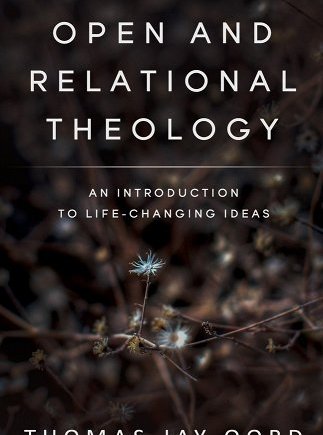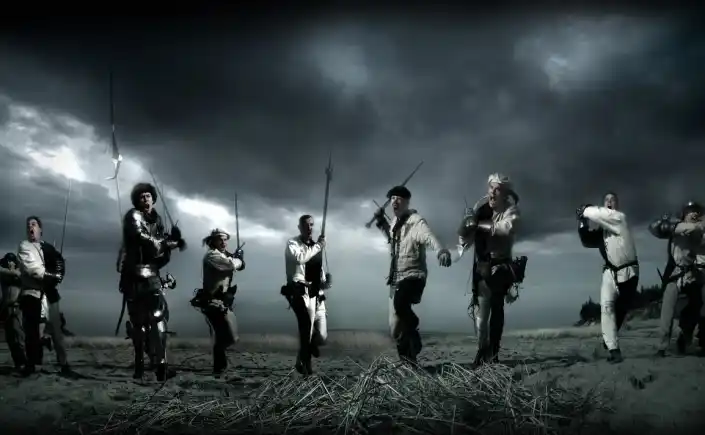In getting back into work on my theological writing, I’ve been reading a lot more theology, perhaps to avoid falling under Samuel Johnson’s warning, “I never desire to converse with a man who has written more than he has read.” I’d like to say that it’s really a matter of humility; the more I learn, the more I realize how little I know. But, ultimately, I just love learning, especially about theology. Over the past weeks, I’ve felt much like I was back in graduate school: reading multiple books a week, and happily, always with highlighter and fine-pointed (.35mm preferred) pen for marginalia. I’ve been reading or re-reading Julian of Norwich, Theresa of Avila, Dr. Elaine A. Heath, Brian McLaren, Tillich, and now Thomas Jay Oord.
Second-hand information about Thomas Jay Oord and his thoughts on God’s passibility have been influential in the formation of my own theological arguments (which you’ll see below, at least in part), so I was excited to sit down and get some first-hand experience with the man. Unfortunately, I relatively quickly found myself thinking of him as I typically think about the comedian Dennis Miller; I can agree with most of his conclusions but want to argue with him the whole way to them.
So, this post will focus on my criticisms of Rev. Dr. Oord’s arguments laid out in this book. In a matter of fairness, I must say that this book is clearly intended for a popular audience and therefore adopts a brisk pace and high-level approach that does not give Oord time or space for laying out the details and nuance of his arguments. However, Oord makes sweeping assertions about the nature of God and the Cosmos in this book that simply cannot stand without support. As often as not, no support is given whatsoever, with the precept stated as undeniable factual revelation. When argument accompanies an assertion, it often suffers from the use of rhetoric to conceal the lack of substantive argumentation, or the argument given doesn’t actually follow to the assertion being made.
As I said above, while I agree with Oord’s framing of God as relational, and I also agree with Oord’s arguments about the importance of free will to God’s intentions for humanity, the roads walked to these conclusions lead down problematic paths before they reach their destinations, however good (or correct) those destinations may be.
God Can’t
Right off the bat, Oord writes about what “God can’t” do. Some of these statements are intended to call out inconsistencies in “conventional” theologies. For example, Oord writes, “A timeless God can’t do anything new or continue doing anything He did previously.” The idea of “time” is unsettled in both philosophy and science; to use words like “timeless,” especially without any definition, in such absolute statements, is insupportable. The usage supposes that (1) that “timeless” is absolutely and incontrovertibly incompatable with being “in time,” (2) that Oord understands how time and timelessness work, and (3) that anyone who calls God “timeless” does not.
Aside from the intellectual hubris of such positions, the failure to address any epistemology whatsoever to delineate assumptions and arguments for how we can know about time and eternity with any certainty, much less what we can know about time and eternity as finite beings, would not pass muster with anyone with more than a passing knowledge of the issues of philosophy, theology, experience and metaphysics. This is the extreme opposite of what Tillich often does in his writings; where Tillich writes in a way that presupposes you have the same definitional understandings of philosophical concepts that he does (whether as a matter of trust of his audience or to demonstrate his intellectual brilliance, I can’t say), Oord presumes the reader doesn’t have sufficient philosophical training to even ask such questions. Thus, they need not be addressed.
This epistemological issue is the first major problem with Oord’s “God can’t” arguments–the history of Christian theology alone (to say nothing of the equally developed philosophies and theologies of other religions) bears two millennia of epistemelogical arguments about what we can and cannot know about the nature of God. Oord’s definitive statements attempt to cut through such problems like they’re the Gordian Knot, but the blade of confidence is not sharp enough to cleave the collected arguments of brilliant thinkers who have yet proved unable to establish definitively what we might know about God.
Oord is certainly aware of all of this, but he only addresses these issues in reference to “absolute apophaticism” (which reference seems to imply that he, personally, created the term when it’s simply the proper words long-used to describe such a position. It’s a strawman argument (as many of his arguments in this book are).
This approach demonstrates exactly why apophatic theology bears fruit, even if we are engaged in cataphatic theology: the apophatic doesn’t simply say we can’t know anything about God (at least not in its less-than-absolute forms); the apophatic approach reminds us that we must be cautious about overstepping the epistemological and logical limits about what we might say about the nature of God. Here, specifically, I think of Tillich’s argument about the “God beyond God.” Tillich warns us of the intellectual problems of describing God as “a being” when God is the “source of all being.” If God is the source of both time and eternity, how could God be limited by either? Our limitations in understanding time and eternity are not God’s limitations in understanding them.
Likewise, Oord later argues that God “learns to love better.” If we’re to take most seriously the statement (and others like it) in scripture that “God is love,” Oord’s statement simply cannot work. If God is the source of love itself–if there is no such thing as love without God–then logic does not follow that there is something about love that God does not already know. To put things more broadly: if God is the source and sustainer of all things, abstract and the specific, potential and realized, how could God not know all things? We’ll turn to arguments about God’s omiscience momentarily in dealing with free will.
The second major argument against the “God can’t” stance is the issue of omnipotence. Oord casually tosses the idea of omnipotence aside, favoring an argument for “amipotence” (we’ll return to that). “Conventional” theology argues that if there is anything that can control or limit God, that thing stands above God. Oord’s arguments rest upon the unspoken idea that existence has rules that did not originate from God and that God must follow–but the only arguments as to why the conventional view might not be correct (again, ignoring thousands of years of philosophical and theological work) is that Oord wants different consequences or results than the one he sees flowing from omnipotence. His intent in moving away from the idea of God as not fully omnipotent, I think, is an attempt to “rescue” God from responsibility for suffering and evil, though it does not, and cannot, accomplish that goal, as we’ll see.
The shame with the “God can’t” argument is that it’s not even necessary to make it. We can more safely speak about what “God doesn’t” or, at least, “doesn’t seem to do,” without disturbing the conventional views of omnipotence and omniscience, and without falling prey to vicissitudes of epistemelogical quandries, and, in doing so, we can arrive at the same conclusions. In fact, the conclusions have greater profundity when they are the result of God’s choices, not God’s limitations. It is far more powerful–and better coincides with the understanding of God that we have in Jesus Christ–to believe that God is omnipotent but refrains from asserting that omnipotence out of love for Creation. That God is more relational than the God who cannot be other than relational. That God truly demonstrates what mercy and grace are better than the one who does not have the choice not to show mercy and grace.
As I’ll argue in the book I’m working on, I believe that the two fundamental aspects of faith that are necessary to support the eternal hope we have in the promises of the Christian God are that: (1) God is omnipotent, thus no other factor or force could thwart God’s plans for us, and (2) God chooses to be good, to be love rather than fear or hatred. These are the most basic arguments about God we find in scripture. The “God can’t” argument rejects both ideas.
Free Will and God’s Foresight
Oord stresses that the free will of humanity is of deep importance to God; I wholeheartedly agree. But Oord again oversteps by making unnecessary arguments. In this case, Oord confidently asserts that God cannot see the future, at least not absolutely, because God’s ability to do so would deprive us of our free will. Oord is certainly not the first person to make this argument in Christian theology; both Judaism and Islam have addressed the same apparent conflict between the foreknowledge of God and the freedom of human will. The debates continue.
Nevertheless, the existence of both human free will and God’s foreknowledge of events does not necessarily conflict. It cannot be conclusively shown that (and is intuitively not the case) that the foreknowledge of an event causes the event. This is the point of David Hume’s thought experiment about the movement of billiard balls: causation is always assumed, never known definitively. If I know what my wife is going to say before she says it, that doesn’t mean I have caused her to say the words; I simply have a privileged position in seeing a little farther down the road than someone who doesn’t know her as well.
One can argue that God’s omnipotence means that God’s foreknowledge does have a causal effect where human foreknowledge (which is imperfect) does not, but it doesn’t follow (and again would not seem to match logic or experience) to assert that God could not refrain from using God’s power.
Ultimately, like the “God can’t” argument, this argument about God’s foreknowledge and our free will is unnecessary; we don’t need God to be blind to the future to be assured that we have free determination and agency in our actions. The only assertion about God to which this argument would be necessary is the argument that God is limited by forces outside of God. Again, the value of apophatic theology is instructive here–why make unnecessary assumptions about God?
A Note about the Trinity
After a brief mention of the idea of the “social trinity,” Oord moves into an argument that “because the social trinity portrays God as essentially relational, it implies that God is essentially timefull.” I’m don’t follow the logic, in part because I’m not sure what Oord means by “timeful,” but my best guess based on the sentences that follow is that time and “sequences of events” (perhaps causation or change in general) are the same thing, which is far from clear. Even more, I’m not sure whether Oord supports this view or not.
In the next paragraphs, Oord employs the poorest of argumentative tricks, reference to ambiguous and unknown authorities, to argue against the trinity. He says “some Christians” don’t believe in the trinity, as if the fact has some bearing on the truth. He later states that “the trinity isn’t in scripture” (the doctrine came out of the belief and practice of the early church and in the analysis of early scripture starting before the finalization of canon), resorting to a sort of literalism when it suits.
Which brings me to the next issue:
Nonsequitur Answers
In Chapter 4 of the book, Amipotent, Oord argues that God is not omnipotent, God is “amipotent.” By amipotent, he seems to mean that God works through humans through means of persuasion and subtle leadership. That piece, by itself, is common in Christianity; we frequently preach and teach about God using humans to advance God’s plan. It feels like half of sermons about the Old Testament at least touch on this idea–Noah, Moses, Saul, David, the Prophets, etc.
But it’s one thing to say that God allows humans to participate in God’s plans for the world and another to say that God lacks the power to do things otherwise. I think of a scene from Game of Thrones, were Petyr Baelish tells Cersei Lannister that “knowledge is power.” She responds by commanding her guards to step forward, then to seize Petyr, then to slit his throat; at the last moment, she feigns a change of heart and tells the soldiers to stand down. She stares Baelish in the eyes and tells him, “Power is power.” Political and social theorists separate “hard” power–Cersei’s kind of power–from “soft” power–the kind Oord assigns to God. Massive problems in the definition of what we mean by God, assumed arguments about the nature of creation and God’s place within it, and then all other aspects of theology emerge when we start from a position that God is not omnipotent, in ultimate control of all things (whether that control is exercised or not), and therefore God’s promises are trustworthy because God necessarily has the means to fulfill them.
Again, it’s assuming that what God does do indicates the limits of what God could do. If we make the argument that, while God could be resurrected after dying, God could not have prevented death on the cross, we necessarily come to a radically different understanding of the incarnation and passion than those still-varied interpretations and views that are “traditional” or “common.” I want to be clear that I’m not pearl-clutching and reacting to the implications of Oord’s arguments as anathematic simply because I don’t like them. I’ll admit, for all that I know and from what little I can prove, Oord could be right. But if he is, we live in a very different universe than the one we see in the greater scope of scripture considered together and through the lens of Jesus. That universe doesn’t have the same kind of hope in God that I believe Christianity reveals.
For what it’s worth, Oord does explicitly reject my particular argument on this matter, though he does state that other “Open and Relational” theologians ascribe to my view. For him, though, he writes, “Nor does God voluntarily self-limit.” The sentence before that states that Oord does not believe that outside forces do not constrain God, but he really makes no argument in favor of this position. And that’s because, ultimately, logic fails to answer the question here. We’re left with the “Could God create a rock so heavy that God could not lift it?”question. If Oord wants to argue that there are “rules” that God must follow (things “God can’t) but that God is not constrained by outside factors or forces, the question becomes: “Can God make a law so strong that even God cannot break it?” Here, the argument becomes circular, because, if the answer is “yes,” then God has necessarily self-limited.
The argument about God’s “amipotence” is, rather transparently, an attempt to relieve God of responsibility for suffering and evil. Later in the chapter, Oord gives us five ideas that “together…solve the problem [of evil and suffering].” Unfortunately, only the first of these ideas actually even addresses the problem. The first precept, the only one on point, simply states that “God can’t prevent evil singlehandedly.” There it is again: God simply can’t. It’s worth noting that this is not–or at least Oord does not explain it as such–a subtle argument that God has created an existential scheme such that God’s other goals for humanity would be prevented if God singlehandedly prevented evil.
Oord’s earlier focus on free will does partially address the problem of evil (though with a “traditional” answer): God has allowed us free will, and some people will use that to do evil. But it does not address the “real” problem of evil and suffering: Why does God allow suffering at all? Natural disasters, disease, old age: all of these are causes of human suffering that are not brought about by free will. If God created the universe, God created in a way that tectonic shift creates earthquakes, that the molten core of an earthlike world gives rise to convective heat that sometimes breaks forth in volcanoes, that we require water to live but can all too easily be killed by it. Did God create in a way that made God occasionally say “oops!” The modifications of stories in Genesis that were taken from earlier Sumerian or Mesopotamian tales indicate that the scribes who wrote the Old Testament were intentionally arguing the opposite. In the Sumerian flood story, the gods overdo it, trapping themselves against the sphere of the heavens as the waters continue to rise toward them. The God of Noah’s flood has no such problem with controlling events.
Before returning to the problem in general, here are the other four arguments Oord gives: (1) “God suffers with us;” (2) “God works with us to heal;” (3) “God works to wring good from bad;” and (4) “God needs our cooperation.” The first three are attempts to mitigate suffering and have nothing to do with causation. The last is simple a repetition that “God can’t.”
The desire to solve the problem of evil and suffering is a very human one. But, in my epistemological skepticism, I believe that it’s not one we can solve. Oord is quick to make definitive statements about the nature of God and the cosmos, but I am not. That said, I find it especially poignant that what is probably the oldest text of the Old Testament provides the best answer available. At the end of the book of Job, God finally shows up to respond to Job’s questions. But few of God’s answers are explicit. God does specifically state that the arguments of Bildad, Zophar and Eliphaz are wrong. Job’s friends have argued that bad things only happen because of sin–that bad things only happen to bad people. God rejects this whole cloth. But the only answer that God gives to the greater question of why there is suffering at all is a rhetorical monologue in which God asks Job if Job has the omnipotence and omniscience of God. Job responds:
“I know that you can do all things, and that no purpose of yours can be thwarted. Who is this that hides counsel without knowledge? Therefore I have uttered what I did not understand, things too wonderful for me, which I did not know.”
Book of Job 42:2-3 (ESV)
Job realizes that Gods ways are higher than his ways; that he is not capable of understanding the true complexities of dessert, evil, and suffering, and that the choice before him is not one of understanding but of trusting that God understands and is in control of what he does not and is not.
Perhaps the answer that we cannot understand and can only choose to trust or not to trust that what and how God has created represents the best way for things to be, even if we cannot see that now, is not a satisfactory one. But it is an answer that finds purchase throughout the Old and New Testaments. I’ve written elsewhere on the blog about the benefits of ambiguity and doubt in both Scripture and faith in general, and I’ll write about the theodical problem more in later posts. For now, I’ll say that it is not for us to “rescue” God from culpability and, at least on this side of the veil between life and resurrection, we’re not going to find a definite answer with our finite minds. Here, though, Oord’s arguments about God’s mitigation of suffering do have value–they demonstrate that God does not allow suffering for no purpose or without a teleological end, even if we can see what that end is from where we stand.
So Close, So Far
I don’t want to leave you with the impression that I believe this book to be of little or no value. Oord has a number of insights with which I agree, at least in principal if not in all the details. The arguments I’ve made above are mostly in matters we need not resolve to get to Rev. Dr. Oord’s larger points that God is about relationships, God interacts with the world and with us individually, and the core of God’s being is love.
While I quibble with the details, and I think there are problematic consequences of Oord’s arguments that ought be addressed, the intent of this book was to reach people and get them to ask some questions that challenge the “traditional” (I’d say conservative) view of Christianity and to see that the God of Jesus is a God of love and hope, not of fear and wrath. It is not intended as a methodical argument of Oord’s views and, I’ll say again, it’s potentially unfair that I’ve used his brief summaries of ideas as methodical arguments to dissect and oppose.
I do think that there are better books on the topic. I’d highly recommend Brian D. McLaren’s A New Kind of Christianity as an alternative to Open and Relational Theology. McLaren’s book is not intended for academics in particular (I don’t think), but it makes detailed and cogent arguments for the positions it asserts. Like Oord’s book, McLaren’s leads the reader to a truer, better, and more hopeful understanding of Christianity than most people (especially without the church but even for many within it) expect. But, it stands up better to scrutiny than Oord’s book and doesn’t rely on strawmen or other rhetorical techniques to assist in convincing the reader.
I will say that I intend to read more of Oord’s work. Whether or not I agree with his ideas, he provides alternative views to mine that lead to similar destinations, so engaging with his work will help me to think about the details of my own arguments. I expect that there are more worthwhile ideas to learn from him.
The Last Word
If by some happenstance, you have read this far, and have enjoyed my rather longwinded and unfortunately critical review of this book, please let me know. As I’ve engaged in deepening my research for my own theological writing, I’ll be reading a lot more theological books. It might be helpful for me to review many of them on the blog as I do, so if there’s an audience for that, tell me!









